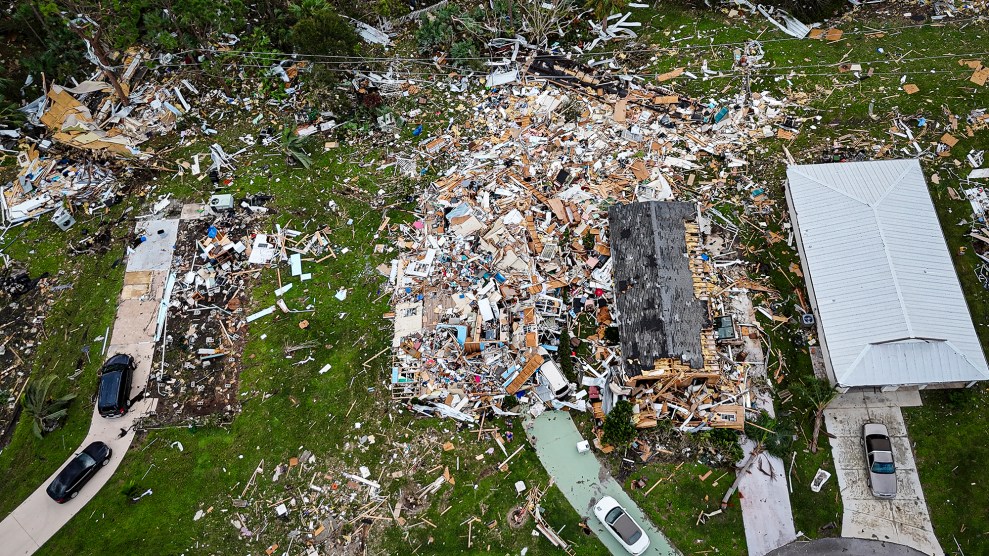
Harvesting almonds in Livingston, California.Dave Getzschman/Merced Sun-Star/AP
When Americans of a certain age hear the word “paraquat,” the first thing that might leap to mind is Mexican weed. That’s because, in the late 1970s, the United States government thought it would be a good idea to pay the Mexican government to spray this potent herbicide on marijuana fields south of the border.
Pot was illegal in every US state then, but plenty of Americans smoked imported weed, and the fear that people were inhaling a nasty chemical along with their THC caused quite the stir.
Bill Allayaud, who is of a certain age, knew immediately what I was talking about. He’s vice president of California government affairs for the nonprofit Environmental Working Group (EWG), a consumer advocacy organization that’s rallying behind a new state bill to ban the spraying of paraquat in California—where I was surprised to learn it is still applied in large quantities by growers of almonds, pistachios, and cotton. The feds’ paraquat ploy “blew up in their face,” Allayaud recalls. “Everyone’s like, ‘What, you’re spraying weed that’s being imported into the United States? Are people getting sick smoking it?”
That would have been hard to track, given that nobody wanted to go to jail. (The feds, in any case, continued with their spraying programs elsewhere.) But even the government acknowledges that paraquat, now banned in more than 60 countries, is highly toxic. A restricted chemical, it has been linked to increased risk of Parkinson’s disease, and to various cancers and neurological problems. The US EPA forbids its use on golf courses, but still lets it be sprayed on crops.
Allayaud points out that in 2017, a firm controlled by the Chinese government acquired Syngenta, the Swiss agri-giant that invented and manufactured paraquat, “and then China banned its use in China!” he says. “Brazil, a giant agricultural economy, has banned its use. The European Union… Because we don’t want to spray it on thousands of acres. Let’s get rid of this stuff.”
An EWG-affiliated nonprofit publication, The New Lede, collaborated with the Guardian in 2022 on an investigation showing—via a trove of documents it dubbed “the Paraquat Papers”—how Syngenta has labored to protect its market position: “Insiders feared they could face legal liability for long-term, chronic effects of paraquat as long ago as 1975,” the report notes. “One company scientist called the situation “a quite terrible problem,” for which “some plan could be made.”
Paraquat does not appear to show up in food, Allayaud clarifies, as it breaks down quickly. The concern is that it binds to the clays in farm soil, where it can persist for months, and get stirred up by tractors and inhaled by farmworkers and others who spend significant time close to fields and orchards. “This is a highly restricted pesticide,” Allauayd says. “You can only spray when there’s low wind—they wear hazmat suits and respirators and gloves when they spray it. But the farm workers who come into the field right after don’t.”
Those farmworkers, not surprisingly, are overwhelmingly Latino. An analysis EWG published in late March showed that California growers sprayed 5.3 million pounds of paraquat from 2017 to 2021. Two-thirds of the spraying took place in just five agricultural counties, all majority Latino. “Study after study has shown that people living right next to these areas tend to have higher rates of various” health problems, Allayaud told me. “Do we really need a 60-year-old pesticide that looks like it could be causing Parkinson’s disease?”
AB 1963, the bill introduced on Wednesday by Assemblymember Laura Friedman (D-Burbank), would phase out the sale and use of paraquat in California by the end of 2025. “Parkinson’s is a thief in the night. It steals peoples’ lives,” the press release states. “While we don’t have a cure for Parkinson’s, we can lessen the incidence rate for agricultural workers.”
There are safer chemicals available, according to team Friedman. There are also nonchemical methods—Allayaud points out that agricultural officials, scientists, and many growers have been emphasizing “integrated pest management,” an approach that aims to reduce the spraying of toxic chemicals via techniques like tilling, crop rotation, and use of natural predators to control insect pests.
Allayaud nevertheless expects that his coalition will face plenty of resistance from Big Ag and its trade associations—as always. They like to claim “the dose is the poison,” he says. “I heard a guy testify to that effect recently in Sacramento. That’s old, old thinking—and unsound science today.”

















